Contact
larryf@happy-wanderers.com
Info
Information on this website is our opinion only. This site was created to help others considering this wonderful lifestyle, and for our own use.
larryf@happy-wanderers.com
Information on this website is our opinion only. This site was created to help others considering this wonderful lifestyle, and for our own use.
We stayed on the "Spit" at Homer from June 24th - July 8th. As expected, the July 4th holiday weekend was a mad-house in the campground. We enjoyed our stay in Homer, but after a couple weeks, we were ready to move on. During our stay in Homer, we hiked in an Alpine Meadow at the Eveline Recreation Area (where I left off in our previous Blog entry). While visiting the Bear Creek Winery, Larry made a deal with the manager to take some aerial photographs of their beautiful facilities in exchange for a case of wine. This was a winning deal for both sides. One of our day trips involved a drive to the nearby town of Anchor Point, with a side trip to Nikolaevsk and the old Russian church. We drove on the beach at Anchor Point and watched them recover boats directly in the ocean with large tractors. There were no boat docks, but there were a dozen Bald Eagles. Part of the significance of this trip was this is the furthest West you can drive in the United States. Another day, Bob and Joyce took the ferry across the bay to the town of Seldovia (Connie and I elected to not go). This whole area has a strong Russian influence, since it was Russian explorers and hunters who settled here (other than the original native tribes).
For one trip, Connie wanted to drive the road out as far we could on the Kenai peninsula. We had done the same while staying in Seward. We went past the end of the pavement of East Road and took a 4WD trail down a steep hill to the beach. We drove a short distance on the beach of Kachemak Bay. I'd say this was the end of the road. From here, we had wonderful views of various large glaciers across the bay. Another day trip took us to the nearby town of Ninilchik with numerous Halibut fishing charters. Of course, another day was spent catching up on laundry - at $5 a load at the Laundromat ($22 in total!)
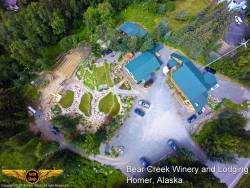 |
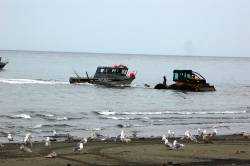 |
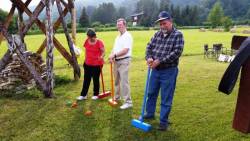 |
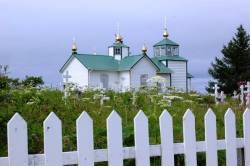 |
One of the main reasons for visiting Homer was for the Halibut fishing. Since I easily get seasick, this didn't appeal to me. But Connie had been looking forward to Halibut fishing for over a year. Connie and Joyce took a full day fishing charter out of Homer. They used a two-for-one coupon from the "Toursaver" book. It was $362 for the two of them. They returned at the end of the day with big smiles, and two large Halibuts each (that's the limit). Okay, they weren't "large", but a 30" fish was large enough for them. After fileting and packing, they ended up with about 16 pounds of Halibut (which sells for $28 a pound here). This is an adventure Connie won't ever forget.
While speaking of Halibut, another afternoon was spent visiting friends of Bob and Joyce who live in Homer. Actually, they are friends of Bob's parents. Tony and Madeline are very friendly people who couldn't wait to have all of us over for a fish fry. They only spend the summers here in a nice home on a hillside overlooking the Kachemak Bay. Wonderful views. The fried Halibut was fantastic, as was the company. Tony has built a "croquet" game in his front yard. But wait, this wasn't any typical game. He used large rebar hoops, painted softballs, and 4"x4" boards for mallets. We had a fun time playing this oversized game of croquet - and Larry won! While sitting around a camp fire, we noticed a beautiful Bald Eagle at the top of a nearby tree. Tony stated, "It must be show and tell time!" Their granddaughter, Paula, went into the house and came out with a couple fish heads. She tossed them high into the air for the eagle to see where they landed. It wasn't far from us in the open front lawn. The eagle was waiting for this and flew down. He was quickly joined by another Bald Eagle. They each made a couple loops over us, then swooped down and snatched up the fish heads. It was pretty exciting to see this ground capture in one swift motion while in flight. We just wished we had the better camera with us.
Also during our two week stay in Homer, we met up other Escapee RV Club "Boomer" friends. We first met at a local Pizza joint and caught up with each others adventures. Later, Connie planned an Independence Day get-together at our RV. Since the weather wasn't the greatest, we were joined by Bob and Joyce Childre, Steve and Pam Ritchie, and John and Connie Parker for a large pot-luck in the motor home. On other days, we visited the Pratt Museum ($8 each) and learned about the history and native cultures of Homer. Another day was spent visiting the "Islands and Oceans" visitor center (free) and learned about the large Alaska Maritime National Wildlife Refuge.
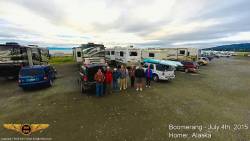 |
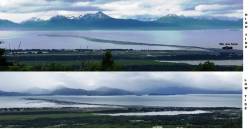 |
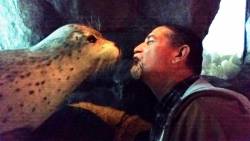 |
 |
Another "unique" feature of the Homer Spit are the tides. Twice a day, there were HUGE tide differences. The tide would go out very far, making over a 24' difference in the water level. After two weeks in Homer, we were ready to move on. We planned to stay at the Hidden Lake campground in the Kenai Wildlife Refuge, but ended up in a beautiful free campsite on the shore of Peterson Lake (60.52496, -150.3975), in the Skilak Recreation Area, which is also part of the Kenai Wildlife Refuge. This was a quiet and very scenic location. We would see a moose almost every morning in the lake nearby and enjoying breakfast of the lily pads in the lake. We stayed here from July 8th - July 13th. During our five night stay, we made a 5 mile hike to the Russian River Falls and watched Red (Sockeye) Salmon trying to "jump" up the falls. These were pretty large falls and wondered how (or if) they would ever make it. We did see some that had gotten about 25% up the falls, so far. This was a real nice hike, on a beautiful day, without hardly any mosquitoes. The falls were magnificent. On this same trip, we stopped at Cooper Landing and toured their small, but interesting town museum. After the hike, we also stopped for lunch and some ice cream.
Another afternoon we went to the St. Elias Brewing in Soldotna for a pizza dinner. Fred Meyer is also there, so we also picked up some more grocery items. We had previously stopped in Soldotna after leaving Homer to fill up on diesel at $3.51 a gallon.
Yesterday, we made another road trip to the top of the Kenai Peninsula to visit the Cook Recreation Area. We can now say we've driven as far you can on the four corners of the Kenai Peninsula. The Cook Recreation area was a little bit of a let-down. Not much there, except some campgrounds. However, there was a day use area that had some wonderful views across the Cook Inlet. Since the weather was great, we could see the oil rigs in the inlet, as well as many volcanoes across the Redoubt Bay. On our return trip, we stopped in the town of Kenai for lunch. We then visited their nice Visitor's Center and took the self walking tour of old Kenai. This was a nice little walk, viewing many of the old and original buildings. The highlight of this walk was looking down from a high bluff at Scout Park to the fishermen onto the mouth of the Kenai River. "Dip Netting" had just started and hundreds of people were lined up along the shore with huge nets dipped into the ocean. They were hoping to net a salmon, which most did. These large nets were being rented for $30 a day and they sell for around $240.
Speaking of fish, we've had a couple dinners with the Halibut that Connie and Joyce caught. The fish tacos were good. We also tried a recipe with Halibut for "Poor Man's Lobster". It was good, but still just tasted like butter to me (but it was flaky). Connie knows I'm not a big fan of fish. Tonight, Connie's going to give a try at the proven fried "Fish and Chips".
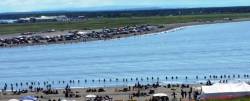 |
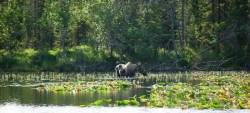 |
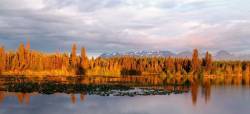 |
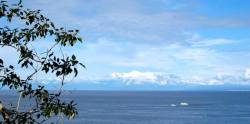 |
For those researching to have their own Alaskan RV adventure, here are our financial facts since crossing into Canada on May 16th to today, July 12th. So far, we've spent $1633 for diesel fuel, $255 for auto gas, $953 for groceries (includes wine and beer), $548 for dining out, $538 for tours (etc.), and $404 for camping (all in US dollars).
When you subscribe to the blog, we will send you an e-mail when there are new updates on the site so you wouldn't miss them.
I also want to email but can't find a way. Also can't comment at the refrigerator article. I hope this fits, feel free to move as appropriate. There are typo type things making it hard for me to understand the refrigerator story:
Your info is a gold mine to me if I can understand it. I’ve tried to clarify somethings, let me know what mistakes I made.
The answer is.... 25AH at 12volts WHEN the compressor is running. Is that 25Ah/hr? 25AH per night (8hrs)? Is that battery draw in addition to compressor AmpHrs supplied? Is 25 correct, or is this the same as 125 AH listed below?
While various conditions will dictate how often the compressor runs, during my test, the compressor ran about 20 minutes each hour. At this rate, the residential fridge would use about 8amps(hr?) each hour while on inverter and batteries. I hope this is correct because this is all the information I am after and whatever I don’t understand about the previous paragraph doesn’t matter. 8AmpHrs/hr at 12V is 96W. I have seen fridges rated around 150W operating minus off time. Your info looks good.
My overnight test showed that with almost everything turned off in the Phaeton, we use about 12AH. This is for the inverter on, the residential fridge on (but not the compressor running), TV's and DVR plugged in and in "sleep" mode, and any other phantom loads. Overnight, we used 120AH in an 8 hour period. This is the test result I’m looking for. How does “we use about 12AH” in the 1st sentence compare to “120AH in 8hrs” at the end? Is the 1st 12AH actually 12AH/hr? If it’s per hour, how did you get to 120AH in 8hrs in the last sentence? That would be 96AH instead of 120AH. Or maybe the 1st 12AH is really supposed to say 120AH, and then is repeated below describing the 8hr results.
Cudos for realizing you can leave the fridge off at night and catch up during the day. Also consider turning the ice maker off at night. Making ice is half the problem, warming it to fall out of the machine is the other half of the problem Safe travels!!
With the battery meter installed, we recently spent the night in a Casino parking lot and got some good readings. The answer to my original question on "how much power does the residential fridge require when on the inverter and batteries" was answered. The answer is.... 25AH at 12volts WHEN the compressor is running. While various conditions will dictate how often the compressor runs, during my test the compressor ran about 20 minutes each hour. At this rate, the residential fridge would use about 8amps each hour while on inverter and batteries. A very manageable number. However, I have seen the power consumption jump to over 50AH with just the fridge running. I presume this the "automatic defrost" running. But this usually doesn't last long and I've only seen it a couple times a month. The next question is how much power is consumed leaving the inverter on all the time. In my case, I'm more interested in how much power is used overnight. My overnight test showed that with almost everything turned off in the Phaeton, we use about 12AH. This is for the inverter on, the residential fridge on (but not the compressor running), TV's and DVR plugged in and in "sleep" mode, and any other phantom loads. Overnight, we used 120AH in an 8 hour period. For my 660AH battery bank, this is less than 25% of my capacity. Since my initial tests, we now turn OFF the inverter at night. This has worked out very well. We save the 120AH of battery usage during the night. Normally, the freezer is 0 or -1 degrees and the fridge is 37 degrees. When we turn the system back on in the morning, the freezer is 9 or 11 degrees and the fridge is 39 degrees. Acceptable temperatures for us. We're not getting into the fridge at night and it's very well insulated.
If you'd like to be notified when we post a new Blog, create a "Subscription" below.
Follow